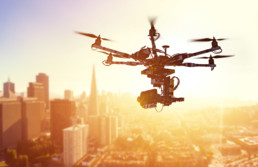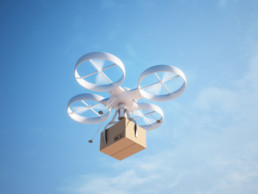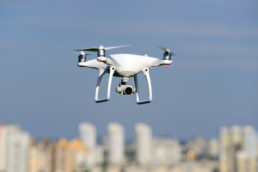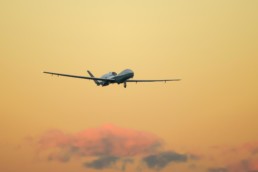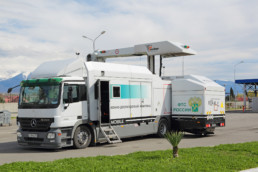SABAFAM Technology Co. is a high-tech enterprise, we have a professional R&D team and we have spent several years in researching and developing different drones. We concentrate on commercial grade unmanned aerial vehicles and UAV application solutions. Currently, we are looking for new applications of drones in the field of Oil, Gas, Marine and ports inspection.
An unmanned aerial vehicle (UAV), commonly known as a drone is an aircraft without a human pilot aboard. UAVs are a component of an unmanned aircraft system (UAS), which include a UAV, a ground-based controller, and a system of communications between the two. The flight of UAVs may operate with various degrees of autonomy: either under remote control by a human operator or autonomously by onboard computers.
Compared to manned aircraft, UAVs were originally used for missions too “dull, dirty or dangerous” for humans. While they originated mostly in military applications, their use is rapidly expanding to commercial, scientific, recreational, agricultural, and other applications, such as policing, peacekeeping, and surveillance, product deliveries, aerial photography, agriculture, smuggling, and drone racing. Civilian UAVs now vastly outnumber military UAVs, with estimates of over a million sold by 2015, so they can be seen as an early commercial application of Autonomous Things, to be followed by the autonomous car and home robots.
Officially, the term ‘Unmanned Aerial Vehicle’ was changed to ‘Unmanned Aircraft System’ to reflect the fact that these complex systems include ground stations and other elements besides the actual air vehicles. The term UAS, however, is not widely used as the term UAV has become part of the modern lexicon.
From SABAFAM perspective, BMS can be worthwhile for customers, specially, amongst Iranians society. Indeed, we can reduce the energy cost in one side as well as saving more energy considerably on the other side.
A building management system (BMS) is a control system that can be used to monitor and manage the mechanical, electrical and electromechanical services in a facility. Such services can include power, heating, ventilation, air-conditioning, physical access control, pumping stations, elevators and lights.
A very basic BMS consists of software, a server with a database and smart sensors connected to an Internet-capable network. Smart sensors around the building gather data and send it to the BMS, where it is stored in a database. If a sensor reports data that falls outside pre-defined conditions, the BMS will trigger an alarm. In a data center, for example, the BMS might trigger an alarm when the temperature in a server rack exceeds acceptable limits.
Depending on the system, BMS software can be installed as a standalone application or it can be integrated with other monitoring programs. More advanced BMSs can monitor and manage a wide range of building services across multiple platforms and protocols, providing facility administrators with a single, shared view of the facility’s operations.
RFID tags are widely used in identification badges, replacing earlier magnetic stripe cards. These badges need only be held within a certain distance of the reader to authenticate the holder. Tags can also be placed on vehicles, which can be read at a distance, to allow entrance to controlled areas without having to stop the vehicle and present a card or enter an access code.
RFID tag behaves outstanding in harsh environment, such as snowing, fogging, raining, unlike artificial video or photographs, which may result in unsharp effect.
Vehicle registration info like plate number, type, application range, annual inspection, owner info will be recorded to achieve vehicle trace-and tracking, which plays an important role in traffic management including access control, monitoring traffic violation, striking fake plates, etc.
Accordingly, SABAFAM company has been willing to be pioneer in developing and utilizing integrated x-ray systems in order to alleviate above-mentioned threats in Iran.
X-ray inspection systems for cargo containers and vehicles have now become a standard feature in many ports. This rapid adoption has been accelerated by the needs of port security, but made practical by the systems’ unique ability to non-destructively penetrate entire containers and vehicles generate images of the contents in just a few seconds.
Even at this large scale, the resulting images are comparable to those obtained through traditional baggage scanning at airports and capable of identifying objects smaller than a baseball Consequently, these systems are commonly employed for manifest verification and contraband interdiction in a variety of environments.
Inspection objectives
Inspection objectives are important considerations for the design and implementation of a cargo screening system and will impact the type and utilization of screening equipment and the process of interpreting the resulting images. X-ray cargo inspection is typically performed for three different (but not mutually exclusive) objectives; manifest verification, homeland security, and contraband interdiction. Screening equipment is often specified or operated differently, depending on the screening objectives.
Manifest verification is often performed for tariff enforcement with the objective to confirm the contents of a container, both in type and quality. Here, operators may choose to examine the container for overall compliance with their requirements, with less focus on small anomalies.
Containers with homogeneous contents can be cleared quickly, especially when prior images of similar shipments are available for comparison and verification. Image inspection for detecting contraband involves a more detailed analysis assuming that the contraband is likely to represent a small percentage of the overall container volume. In addition, perpetrators are expected to intentionally disguise or hide the materials of interest. In these cases, inspectors must examine both
the cargo itself and the common vehicle hiding areas such as the frames or tanks. Because some contraband can be disassembled into component parts and distributed among permissible cargo, a combination of operator training and advanced software features provides a robust capability to help identify such violations.
The newest and perhaps most urgent need for screening cargo containers comes from the threat of smuggled special nuclear materials. The rarely expected occurrence of this event is offset by its potential impact should such material be used for terrorist purposes. Fortunately, the densities of special nuclear materials make them clearly visible on X-ray images in contrast to virtually all permissible products. Additionally, the advent of dual-energy screening systems adds a second level of material discrimination, allowing software to clearly identify the unusual nature of this threat.




